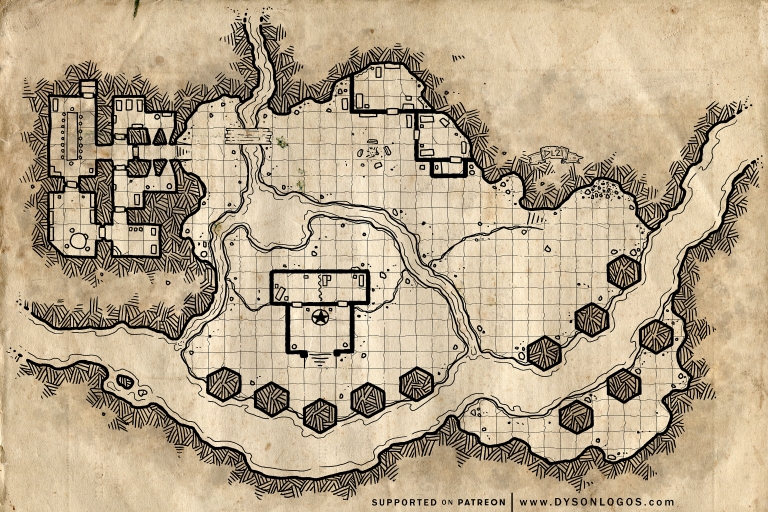This one taunts me. It crouches on one knee at the bottom of the “Ideas” drawer. When I open the drawer, it gawks at me. Its protuberant eyes—perfect circles, all whites—fix me with unmoving stare. Dark blue lips, segmented like two worms, rim the inky hole mouth. It has not teeth nor gums, only bare jawbones that gnash the air when it speaks.
Certain has it crept from far beneath the lighted world, through cramped passageways, mayhap along the very watercourse whose banks are lined on the water-stained pages it presses under a flabby arm.
Jaws gnashing, blue lips quaver in slow undulation, and in a voice, not a whisper but so quiet one must bend into the drawer to hear, it rasps, “The horror… the horror…”
It would be a huge project. To date, Dyson Logos’s Heart of Darkling comprises 28 maps for 17 adventure locations. On the Dodecahedron, Dyson states his intention: 20 locations on the subterranean river and the lake at its mouth, the number of maps for which could exceed 40.
The taunt: to stock the score of adventure locations of Heart of Darkling to complete the underworld campaign.
Not that I myself would ever undertake such an endeavor. Should one be so daring, a Heart of Darkling campaign might be inspired by Joseph Conrad’s 1899 novella Heart of Darkness, augmented by Francis Ford Coppola’s film Apocalypse Now Redux (2001), and filled out with a study of critical analyses on both to include their themes and devices in the campaign.
As a major theme of the novella is criticism of colonialism and its exploitation of indigenous peoples, a campaign might take the opportunity to address issues with which DUNGEONS & DRAGONS now struggles. They are, generally, how the game portrays various fantastic races and how alignments are used in the game setting. This should be done well, with respect and empathy, or not at all.
Moreover, I’m not convinced that addressing such delicate issues within the game itself is a good idea. Our notions and attitudes about race and alignment in the game are ever-changing—one hopes toward the more inclusive. An attempt to portray better ways to handle these elements in a product would be only a snapshot of progress at the time of publication.
On the other hand, like Conrad’s novella, a work of art is often such a snapshot. A snapshot taken of a moving shoreline along a journey through our own hearts of darkness.
 The Pillars.
The Pillars.In conversation with the map god, he might give away his intended location, obvious when we read the text, for the climactic scene as the Pillars, where abides the charismatic ur-priest and its flock of deep-dwelling humanoids.
“The horror! The horror!”